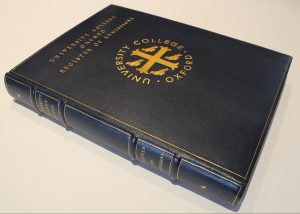- arthur@greensbooks.co.uk
- 01684 310106
Bookbinding
In addition to conserving books, we also offer a bookbinding service; creating new bindings for both completely new books, and those with old bindings beyond repair. Bindings are hand-made to order, and particular care is taken to accurately replicate historic structures and styles. Below are a few examples of past bookbinding projects; if you would like to commission a binding, please contact us to discuss options.
For inspiration, see our gallery for more bookbinding projects.

An early 16th century English Gothic binding:
An early 16th century English Gothic binding with blind-tooled, recessed tawed spine covering over quarter-sawn oak boards. The finishing tools were produced especially for this project and Arthur made the fore-edge clasps from scratch. For further details, see our YouTube channel for Arthur’s Society of Bookbinders’ Lecture: A Gothic Wooden-Board Binding: The Conservation and Rebinding of an Early Printed Book

An early 17th century Oxford pulp-board binding:
This particular binding was the focus of a workshop given in 2018 for Designer Bookbinders and The Society of Bookbinders. For further details, see our blog by Book Conservator, Talitha Wachtelborn.
 A late 17th century leather binding:
A late 17th century leather binding:
A rebind of a late 17th century book on witches that came to us in a rather brutal 20th century library-style binding. The old binding was carefully removed, and the text-block repaired and re-sewn on raised cords – leaving the original sewing intact. It was then rebound in-boards with new plain linen endbands and covered tight-back in sprinkled hand-dyed calf. The board edges were gilt and the blind tooling is restrained, but gives a suggestion of the period.
 An early 18th century panel binding:
An early 18th century panel binding:
The Antient and Modern History of The Famous City of York;… / Thomas Gent (York, 1730). This octavo arrived in the studio in a broken 20th century case-binding; so on this occasion was rebound in-boards with a tight-back, and covered in calf decorated with an 18th century style Cambridge panel.
For more images, see our Gallery.
 A 19th century full leather binding:
A 19th century full leather binding:
A fine binding in period style with four false raised bands on a hollow back; and gold edges and hand-worked red endbands. Fully covered in maroon goat leather and gold-tooled with a black leather label.
 Springback visitors’ books:
Springback visitors’ books:
These two books are bound as springbacks – a style of stationery binding common in the 19th century. They are robust and open completely flat, so well suited for visitors books. For more information on springback bindings see Arthur’s 2011 article.
 A Contemporary binding for the Admissions Register for University College, Oxford:
A Contemporary binding for the Admissions Register for University College, Oxford:
This new binding is next in a series of College Registers dating back to 1764. As requested, the register was hand-bound in a modern style; covered in fine goat leather and finished with the College crest in yellow leather on-lays. For more details, see University College, Oxford.

Wedding guestbook:
A landscape stub-binding; quarter-covered in blue goatskin with gilt edges and personalised with matching leather label. For more images, see our gallery.
